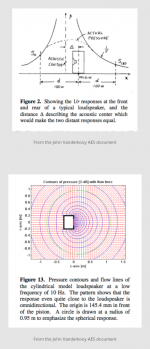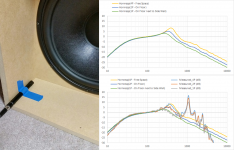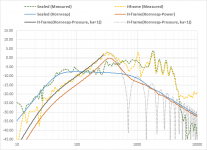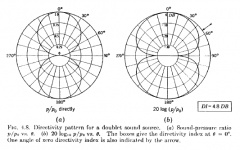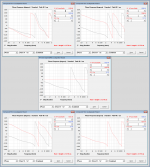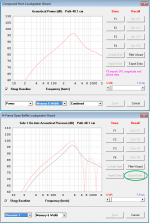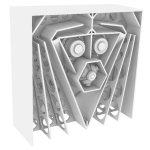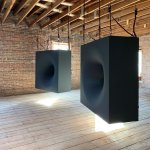This is just my general impression and recollection, its been a while since I studied the patents but its muddy because some Synergy claims repeat unity claims shame on the PTO
Synergy improves upon Unity primarily in the XO, or I suppose in how you locate ports so as to get a better, passive XO. But if you use DSP delay to get to time alignment then you are (most likely) not in violation, as the patent really is about how to position mids to facilitate a passive XO. Being able to do Synergy with a relatively simple passive XO gives a huge commercial advantage over using DSP. although that advantage is diminishing as DSP becomes more common and cheaper.
Synergy improves upon Unity primarily in the XO, or I suppose in how you locate ports so as to get a better, passive XO. But if you use DSP delay to get to time alignment then you are (most likely) not in violation, as the patent really is about how to position mids to facilitate a passive XO. Being able to do Synergy with a relatively simple passive XO gives a huge commercial advantage over using DSP. although that advantage is diminishing as DSP becomes more common and cheaper.
still confusing
Okay what if I follow Art built 100% (i.e paying the fee e.t.c per Art's) and selling to make a profit, Am I violating the patent?
If you're making something for yourself without any monetary gain you are not violating the patent rules.
Okay what if I follow Art built 100% (i.e paying the fee e.t.c per Art's) and selling to make a profit, Am I violating the patent?
Okay what if I follow Art built 100% (i.e paying the fee e.t.c per Art's) and selling to make a profit, Am I violating the patent?
Ask Art.
thank for chime inThis is just my general impression and recollection, its been a while since I studied the patents but its muddy because some Synergy claims repeat unity claims shame on the PTO
Yes, both still follow 1/4 WL. The passive XO on SH50 is ridiculous and complex.Synergy improves upon Unity primarily in the XO, or I suppose in how you locate ports so as to get a better, passive XO
maybe it is the key difference?But if you use DSP delay to get to time alignment then you are (most likely) not in violation, as the patent really is about how to position mids to facilitate a passive XO.
…Thanks for the thanks, but the person to really thank in this case is 'bolserst', for making his "acoustic centre" dipole model available for use in Hornresp. His very elegant model produces results that have proven to be most accurate when compared against the measured performance of actual "doublet source" loudspeakers…
Glad to see this model for defining the effective path length between front and rear sources of dipole woofers has finally made it into Hornresp. As usual, you did a great job of cleanly inserting/implementing it into the existing Hornresp framework
For those unfamiliar with the acoustic center concept, a pictorial description is shown in Attachment #1. Basically, at low frequencies (baffle and driver are small relative to the wavelength) the source can be treated as a point. However, polar measurements indicate that this point source is not located at the driver cone but rather a distance in front of the baffle/driver. The distance to the acoustic center is mainly defined by the size of the baffle, but is also affected by the size of the driver, and the depth of the cabinet. John Vanderkooy’s set of papers in JAES on the acoustic center concept for loudspeakers at low frequencies was the main technical source for the model. Many thanks to mwmkravchenko for help in tracking down these papers and many of the references. For Hornresp implementation, the concept was extended to account for mirroring of the source and enclosure/baffle as you move from 4-Pi space to more restrictive radiation spaces.
As a brief example, here are some measurements I took earlier this spring for a Peerless SLS-12 woofer in a 64 liter sealed enclosure and a short H-frame compared to Hornresp.
Attachment #2: Before taking outdoor measurements, I grabbed a few measurements of the H-frame cavity resonance. I was curious how well the Hornresp radiation impedance model worked for different radiation spaces. Looks pretty good to me
 . 4-Pi measurement was with H-frame on stand in middle of garage. 2-Pi was with H-frame on the floor. 1-Pi was with H-frame on floor up against one wall.
. 4-Pi measurement was with H-frame on stand in middle of garage. 2-Pi was with H-frame on the floor. 1-Pi was with H-frame on floor up against one wall.Attachment #3: Moving outdoors, I took measurements of the same SLS-12 woofer in a sealed enclosure and H-frame at a distance of 2m. Although wind was causing more LF noise than I would have liked, you can clearly see that the level of the LF pressure response calculated by Hornresp for the H-frame lines up very well with the measurements relative to the sealed response. This indicates that the calculated path length between sources is correct.
Attachment #4: Note that the power response for the H-frame in Attachment #3 is roughly 4.8dB below the measured on-axis pressure response. This is because of the DI (Directivity Index) inherent in dipole sources. In other words, a dipole source will measure 4.8dB louder on-axis than a monopole source of the same strength. Or conversely, for the same on-axis SPL level, a dipole source radiates less total acoustic energy into the room than a monopole.
Attachments
Glad to see this model for defining the effective path length between front and rear sources of dipole woofers has finally made it into Hornresp. As usual, you did a great job of cleanly inserting/implementing it into the existing Hornresp framework. I have found it to closely match low frequency measurements for H-frame as well as flat baffle dipoles. Additionally, the flat baffle results match nearly perfectly with those calculated using BTM diffraction methods.
For those unfamiliar with the acoustic center concept, a pictorial description is shown in Attachment #1. Basically, at low frequencies (baffle and driver are small relative to the wavelength) the source can be treated as a point. However, polar measurements indicate that this point source is not located at the driver cone but rather a distance in front of the baffle/driver. The distance to the acoustic center is mainly defined by the size of the baffle, but is also affected by the size of the driver, and the depth of the cabinet. John Vanderkooy’s set of papers in JAES on the acoustic center concept for loudspeakers at low frequencies was the main technical source for the model. Many thanks to mwmkravchenko for help in tracking down these papers and many of the references. For Hornresp implementation, the concept was extended to account for mirroring of the source and enclosure/baffle as you move from 4-Pi space to more restrictive radiation spaces.
As a brief example, here are some measurements I took earlier this spring for a Peerless SLS-12 woofer in a 64 liter sealed enclosure and a short H-frame compared to Hornresp.
Attachment #2: Before taking outdoor measurements, I grabbed a few measurements of the H-frame cavity resonance. I was curious how well the Hornresp radiation impedance model worked for different radiation spaces. Looks pretty good to me. 4-Pi measurement was with H-frame on stand in middle of garage. 2-Pi was with H-frame on the floor. 1-Pi was with H-frame on floor up against one wall.
Attachment #3: Moving outdoors, I took measurements of the same SLS-12 woofer in a sealed enclosure and H-frame at a distance of 2m. Although wind was causing more LF noise than I would have liked, you can clearly see that the level of the LF pressure response calculated by Hornresp for the H-frame lines up very well with the measurements relative to the sealed response. This indicates that the calculated path length between sources is correct.
Attachment #4: Note that the power response for the H-frame in Attachment #3 is roughly 4.8dB below the measured on-axis pressure response. This is because of the DI (Directivity Index) inherent in dipole sources. In other words, a dipole source will measure 4.8dB louder on-axis than a monopole source of the same strength. Or conversely, for the same on-axis SPL level, a dipole source radiates less total acoustic energy into the room than a monopole.
Awesome stuff! A great addition to the Hornresp simulation abilities. Some of the sims versus the measurements are pretty close! Depending on the nearest reflective surface in the measurements some of the sims could be even closer.
Work well spent and greatly appreciated.
Synergy improves upon Unity primarily in the XO, or I suppose in how you locate ports so as to get a better, passive XO.
This is correct, but it is not claimed in the patent, so not enforceable.
What exactly is protected by the Synergy Patent???
here are some measurements I took earlier this spring for a Peerless SLS-12 woofer in a 64 liter sealed enclosure and a short H-frame compared to Hornresp.
Thanks bolserst
Kind regards,
David
hornresp subreddit
David, I created a reddit page for hornresp and want to make you the admin. https://www.reddit.com/r/hornresp/
You should approve moderators from this thread who are also Reddit savvy. The https://www.reddit.com/r/diysound/ has good moderators, and I bet a few of them are active in this thread.
I was going to bring up the creation of a hornresp subreddit, but I was afraid somebody would create a trash sub and not turn control over to you. This way, it's all yours.
Kind regards,
MG
Thanks bolserst.
Kind regards,
David
David, I created a reddit page for hornresp and want to make you the admin. https://www.reddit.com/r/hornresp/
You should approve moderators from this thread who are also Reddit savvy. The https://www.reddit.com/r/diysound/ has good moderators, and I bet a few of them are active in this thread.
I was going to bring up the creation of a hornresp subreddit, but I was afraid somebody would create a trash sub and not turn control over to you. This way, it's all yours.
Kind regards,
MG
David, is there an import/export file format specification?
I am using FreeCAD to generate my horn CAD file from a python script. I thought I might as well generate the hornresp record for the horn, improving turnaround time.
I have exported a record. Most lines are easily identifiable. But there are some weird data as well.
Thanks
Mårten
I am using FreeCAD to generate my horn CAD file from a python script. I thought I might as well generate the hornresp record for the horn, improving turnaround time.
I have exported a record. Most lines are easily identifiable. But there are some weird data as well.
Thanks
Mårten
I know you are asking David directly, but in looking at the export function, *.txt is TAB delimited, and *.csv is COMMA delimited. Each record is delimited with a CRLF.
Symmetrical horn: The first two lines is header info, and the rest of the lines are a linear position of a center line in cm, the area of the horn cross section in sq cm, the radius of the horn cross section in cm, and finally the angle after that position in degrees.
Rectangular horn: The first two lines is header info, and the rest of the lines are a linear position of a center line in cm, the area of the horn cross section in sq cm, the cross section side length in cm, the cross section side height in cm, the top length in cm, the cross section width in cm, and the width flare type.
Petal horn: The first two lines is header info, and the rest of the lines are a linear position of a center line in cm, the area of the horn cross section in sq cm, the radius of the horn cross section in cm, the interior radius (I need help with this one) of the cross section in cm, the side length (I need help with this one) of the section in cm, the width (square root?) of the cross section and finally the number of petals.
I do not know why the data is broken up into multiple sections.
When David wakes up, perhaps he will spell this out better and explain the things I italicized.
Symmetrical horn: The first two lines is header info, and the rest of the lines are a linear position of a center line in cm, the area of the horn cross section in sq cm, the radius of the horn cross section in cm, and finally the angle after that position in degrees.
Rectangular horn: The first two lines is header info, and the rest of the lines are a linear position of a center line in cm, the area of the horn cross section in sq cm, the cross section side length in cm, the cross section side height in cm, the top length in cm, the cross section width in cm, and the width flare type.
Petal horn: The first two lines is header info, and the rest of the lines are a linear position of a center line in cm, the area of the horn cross section in sq cm, the radius of the horn cross section in cm, the interior radius (I need help with this one) of the cross section in cm, the side length (I need help with this one) of the section in cm, the width (square root?) of the cross section and finally the number of petals.
I do not know why the data is broken up into multiple sections.
When David wakes up, perhaps he will spell this out better and explain the things I italicized.
Last edited:
Wow, 25 people joined and you are the only 1 who posted TWICE???
I'm trying to help out by setting this up. I plan on turning it over to David. If he doesn't want it, then I am fine. It is interesting that I am getting slapped for being nice and pitching in. No good deed ever goes unpunished.
Indeed. I had hoped to have time to measure in a large gymnasium like I had done in the past for my ESL theory-vs-measurement work, but have not been able to work it into my schedule yet. Fortunately the driveway measurements were adequate to confirm the SPL level and trend was modeled correctly. That has been the missing piece for modeling H-frames and flat bafffles in Hornresp...deciding on the appropriate path length to use between the front and rear sources....Depending on the nearest reflective surface in the measurements some of the sims could be even closer.
@ D.McBean,
I noticed a couple things when playing around with the H-frame Wizard tonight.
1) If S1=S2=S5=S6, then phase response is plotted as zero.
2) Small changes in any of these areas results in 4 other unique phase plots. Attached pic shows changes with S1 and S2, but similar behavior is seen with S5 and S6.
3) There doesn't seem to be a way to export the pressure responses, only the power response. This may be as intended but thought I would mention it anyways.
I noticed a couple things when playing around with the H-frame Wizard tonight.
1) If S1=S2=S5=S6, then phase response is plotted as zero.
2) Small changes in any of these areas results in 4 other unique phase plots. Attached pic shows changes with S1 and S2, but similar behavior is seen with S5 and S6.
3) There doesn't seem to be a way to export the pressure responses, only the power response. This may be as intended but thought I would mention it anyways.
Attachments
On another note David, at 10,000 posts I'd like to thank you for a fantastic contribution you have made to the world of DIYAudio.
To celebrate I've attached some pictures of a more complex build that used Hornresponse to model several parts.
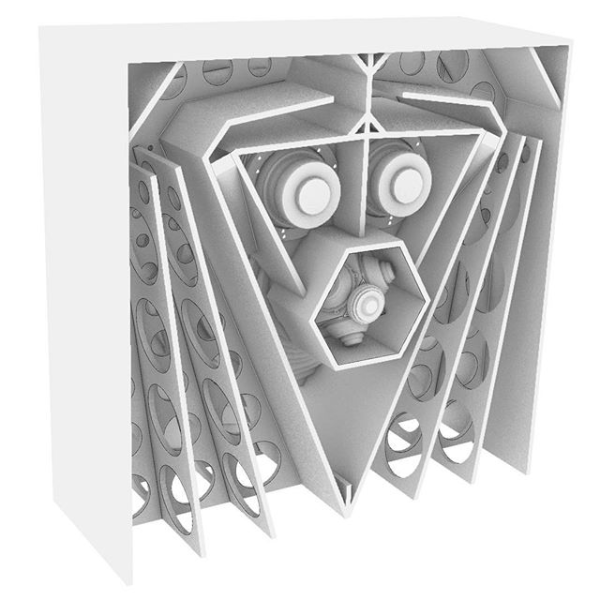
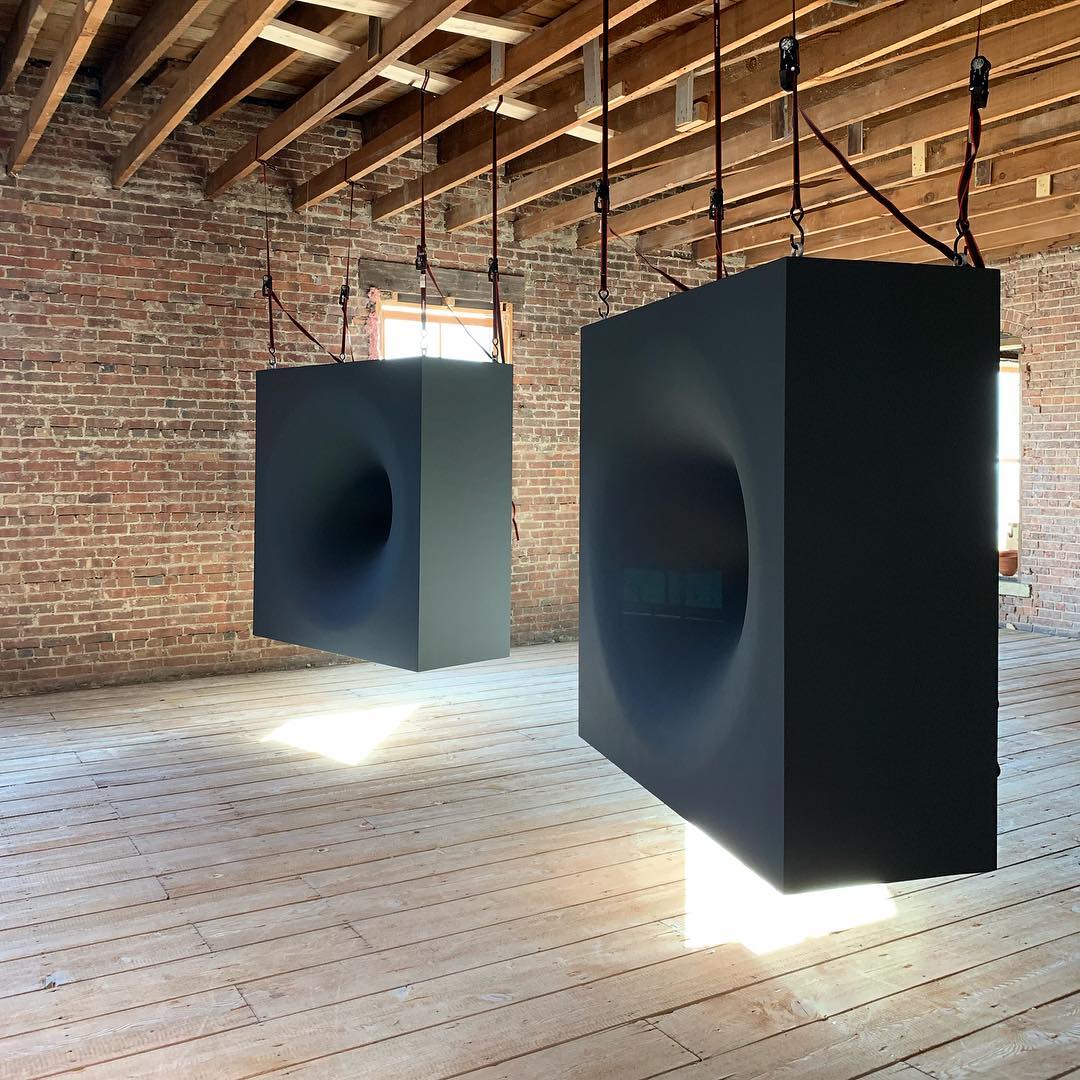
Thanks again for your efforts in continual development and support!
To celebrate I've attached some pictures of a more complex build that used Hornresponse to model several parts.
Thanks again for your efforts in continual development and support!

Attachments
I created a reddit page for hornresp and want to make you the admin. https://www.reddit.com/r/hornresp/
Hi MG,
Thanks for taking the trouble to create the reddit page, but I have been using this diyAudio thread for so long now that I would find it difficult to make any change - it is hard to teach an "old dog" new tricks
Kind regards,
David
- Home
- Loudspeakers
- Subwoofers
- Hornresp
